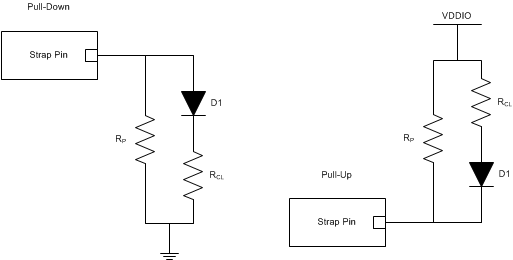SNLS676 May 2022 DP83TC813R-Q1 , DP83TC813S-Q1
PRODUCTION DATA
- 1 Features
- 2 Applications
- 3 Description
- 4 Revision History
- 5 Device Comparison Table
- 6 Pin Configuration and Functions
- 7 Specifications
-
8 Detailed Description
- 8.1 Overview
- 8.2 Functional Block Diagram
- 8.3 Feature Description
- 8.4
Device Functional Modes
- 8.4.1 Power Down
- 8.4.2 Reset
- 8.4.3 Standby
- 8.4.4 Normal
- 8.4.5 Sleep Ack
- 8.4.6 Sleep Request
- 8.4.7 Sleep Fail
- 8.4.8 Sleep
- 8.4.9 Wake-Up
- 8.4.10 TC10 System Example
- 8.4.11 Media Dependent Interface
- 8.4.12 MAC Interfaces
- 8.4.13 Serial Management Interface
- 8.4.14 Direct Register Access
- 8.4.15 Extended Register Space Access
- 8.4.16 Write Address Operation
- 8.4.17 Read Address Operation
- 8.4.18 Write Operation (No Post Increment)
- 8.4.19 Read Operation (No Post Increment)
- 8.4.20 Write Operation (Post Increment)
- 8.4.21 Read Operation (Post Increment)
- 8.5 Programming
- 8.6 Register Maps
- 9 Application and Implementation
- 10Power Supply Recommendations
- 11Layout
- 12Device and Documentation Support
- 13Mechanical, Packaging, and Orderable Information
Package Options
Mechanical Data (Package|Pins)
- RHF|28
Thermal pad, mechanical data (Package|Pins)
- RHF|28
Orderable Information
8.5.2 LED Configuration
The DP83TC813S-Q1 supports 1 configurable LED pin (LED_1) which also doubles up as a clock output pin (CLKOUT). Several functions can be multiplexed onto the LEDs for different modes of operation. LED operations are selected using registers 0x0450.
Because the LED output pins are also used as strap pins, external components required for strapping and the user must consider the LED usage to avoid contention. Specifically, when the LED outputs are used to drive LEDs directly, the active state of each output driver is dependent on the logic level sampled by the corresponding input upon power up or hardware reset.
Figure 8-19 shows the two proper ways of connecting LEDs directly to the DP83TC813S-Q1 .
 Figure 8-19 Example Strap Connections
Figure 8-19 Example Strap Connections